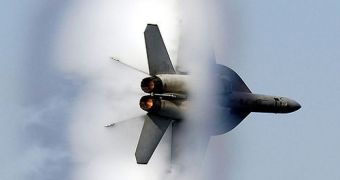Overtired by the restriction it's subjected to, NASA is currently working on methods to suppress the loud sonic boom that aircrafts make when breaking the sound barrier, by flying at speeds higher than 700 miles per hour. Because of the loud noises, the American Space Agency is prohibited to operate some of its Unmanned Aerial Vehicles (UAV) above the ground, because of the discomfort they bring to the population. Some of these UAVs have close to 10 Mach capabilities, yet their potential is restrained by the noise they make.
The infamous sonic boom, first heard when Chuck Yeager flew a Bell XS-1 research plane at a speed of over 700 mph, on October 14th, 1947, is generated by shock waves gathering in front and at the back of the plane, when the machine starts moving beyond the speed of sound. According to researchers at NASA, the loudness of the noise is directly proportional to the geometry of the airplane, so now engineers are working on new ways to design aircrafts that will drastically reduce, or even eliminate, the loud bang.
At its Dryden Flight Research Center in Edwards, California, the American space agency conducted a series of mid-flight tests with two F-15 planes. One flew at high-speeds to break the sound barrier, while the other trailed behind at a lower altitude, and about 500 meters behind. A specially-designed sensor cone, specifically projected to measure the intensity of the shock waves generated by the first plane, was placed on the nose of the second aircraft.
The leading plane was retrofitted with small airfoils in front of the wings, called canards, which helped control the amount of lift the wings got, as well as with engine nozzles that could be adapted in flight. These nozzles change the exhaust plumes from the engines, and thus influence the amount and intensity of the shock waves that are generated at the back of the plane.
The recorded data was sent to NASA's Langley Research Center in Hampton, Va., to NASA's Ames Research Center at Moffett Field, California, and to Dryden, and fluid mechanics experts will attempt to interpret it in a manner that could help them build a new class of airplanes, invisible both to radar and to acoustic detection.

 14 DAY TRIAL //
14 DAY TRIAL //